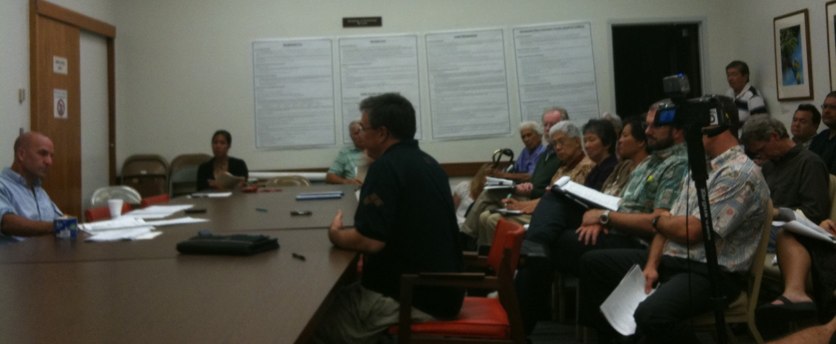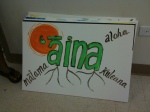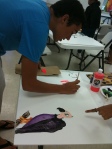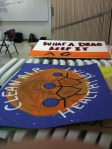Blog
News, updates, finds, stories, and tidbits from staff and community members at KAHEA. Got something to share? Email us at: kahea-alliance@hawaii.rr.com.
Reading: Environment Hawai'i, August Issue
We got our August issue of the excellent Environment Hawai’i in the mail the other day!
On DAR’s proposed list of activities that they believe should be exempted from doing environmental assessment, they write, “DAR’s proposed list appears to exempt every type of permit and license issued by the division.” Including live rock and coral collecting permits and all permits for Papahanaumokuakea in the Northwestern Hawaiian Islands.
There is also great coverage of Waimanalo Gulch violations and wet-noodle enforcement from the Department of Health, and excellent reporting on this summer’s WESPAC meetings.
Mahalo to Pat and Teresa for their excellent investigative reporting! You can support Environment Hawai’i by subscribing today!
Laughable public process: changes to conservation protections

Hearings officer Sam Lemmo, the administrator for OCCL, made a point of assuring the room that the final regulations would definitely be different from what we are seeing tonight based on all of the great input they had been getting. (Did you just feel that gentle pat on the top of your head? I did.)
We pressed Sam on when we might actually see the final regulations. Generally speaking, the agenda for the Board of Land and Natural Resources is posted a mere six-days before the Board decides an issue. Will we only get six days to review the final version of the rules that are supposed to be protecting our conservation lands for at least the next 15 years?
In response, Sam chuckled and said “good question.” The audience laughed. I laughed, too — because what do you do when someone laughs in your face? Despite all the laughter it was a sad moment.
It is sad when regulations as important as these are given but the bare minimum of study and public process. We are talking about 2 million acres of conservation lands — our watersheds, nearshore waters… the important places. Conservation lands are 51% of the crown and government lands that are supposed to be held in the “ceded” lands trust for Native Hawaiians and the people of Hawaii — we have an obligation to protect these assets.
From what I hear from the old-timers, when these rules were changed 15 years ago, there was a public blue ribbon panel convened to advise the division on improving the regulations. Today, DLNR is unilaterally proposing major revisions. What gives? Where is the expert panel? The thoughtful study? The reasoned assessment?
In response to my quote on the need for “a blue ribbon panel” in the Star-Advertiser on Thursday, several insiders came forward at the hearing to thank Sam for DLNR’s history of work on these rule changes that were, in their words, “a long-time coming.” So long in coming, in fact, that the public just heard about them. These rules saw the first light of day in July and are expected to be approved before December. Coincidentally, that’s right before the Lingle Administration leaves office. Feels more like a 50-yard dash than a “long-time coming” to me.
Both in and out of public hearings, we have heard Sam say, at least 20 times (no exaggeration, I seriously counted), “Good question, that wasn’t what I intended” in response to questions and concerns about the staff’s proposed changes. I don’t know about you guys, but if what I write down isn’t what I meant to say, its usually because I was in a rush and didn’t take the time to think about the implications… welll… that kind of pondering is exactly what we need right now.
Good changes, bad changes, the bottom line is these changes need more thought. We should not let the timeline for the end of an administration drive the schedule for amending some of the most important protections in our islands.
Want to feel like you were there? Here is a link to notes from the Honolulu public hearing on August 12, 2010.
Want to participate in the process? Sign up for KAHEA’s action alert network, later this week we’ll send out an easy-to-use comment form by email.
Signs of Aloha Aina
From Marti:
We had our first sign-making party in the “Keep Waianae Country” effort. We are getting ready for the Land Use Commission to visit the parcel of farmland that Tropic Land proposes to turn into an industrial park. Their visit happens on Wednesday August 18th at 1:30 pm.
Want to join us? We’ll be on Farrington Highway where it intersects with Lualualei Naval Access Road and with Hakimo Road at 1:00 pm.
Can’t make it, but still want to participate? Then make a sign in support of keeping Waianae country, take pictures of you and your friends holding the sign, and then send the pictures to us at miwa(at)kahea.org. We’ll make sure the LUC sees it.
And if you live along the navy road or Hakimo road, then hang a sign on your fence where everybody can see it. We’ll be passing out the beautiful signs we made next week. Let us know if you want one.
Big Mahalo to everyone who came out to help us make signs. It was a lot of fun. And who knew Tyler would turn out to be poster-painter extraordinare… in addition to top ace legal intern?! Finger painting ain’t just for kids anymore!
A few last words...
From Tyler, our summer fellow from the Center for Excellence in Native Hawaiian Law at the UH Richardson School of Law:
My time here at KAHEA has come to an end. School’s about to start back up, which means I’m unavailable until next break. I’ll miss you all. I know what you’re thinking, but who will write witty blogs? I don’t know. However, if you want to hear more from me, please e-mail KAHEA, and overwhelm them with requests to bring Tyler back to KAHEA during Winter break and next Summer, because you can’t live without him. Start a petition. Start a Facebook group.
I had such a wonderful time working with wonderful people gaining life experiences and worthwhile skills. Who could believe that two months would create such lasting bonds and impressions. I promised myself I wouldn’t get emotional. I need a tissue. And more coffee. Until next time friends…
Super Intervenors: An Update

(Mahalo to the talented Mark Fiesta for the picture)
The latest scoops from legal intern Tyler on legal proceedings around the push to protect agricultural and preservation lands in Waianae currently threatened with industrialization. Fenceline to farms and homes, an industral park and new landfill are proposed on this area in the middle of one of Hawai’i's largest communities of Native Hawaiians. It’s a justice thing, and it’s a kākou thing!
From Tyler:
We last left you with some tremendous victories following the Land Use Commission’s granting our Motion to Intervene. This means, as you may remember, that we get to sit at the big kids table and play hardball. As dates are solidified and we proceed, our first act as official Intervenors is to order fancy name plates for our desks that say “Intevenor” on them. That was a joke. They say “Super Intervenor.”

All jokes aside, our first OFFICIAL act was to submit a Statement of Position. It’s essentially a formality that lets everyone at the big kids table know what we’re playing for. Environmental and cultural justice. Here’s what we believe to be true:
Tropic’s proposed development ignores:
1) The cultural significance of Wai‘anae
2) The Wai‘anae Sustainable Communities Plan
3) The characterization of Urban land
Think of this as a game of Monopoly. Tropic Lands owns a parcel not on the game board. Let’s call it Insensitive Avenue. They really want to be in the game, because they believe they can make a nice chunk of change. But they can ONLY do this on Insensitive Avenue. So what do they do? They cry “JOBS!” and then they ask the state Land Use Commission (LUC) if they can amend the rules and put Insensitive Avenue on the game board.
The problem is: If we let Insensitive Avenue on the game board, then we MUST put Greedy Place and The Capitalism Railroad into play. And in fact, this is the purpose of the rules. The reason Community Plans and Zoning Regulations are made? To prevent unruly development in a community and to maintain balance. Not to mention mediating ongoing insensitivity to cultural concerns.
We understand the need for economic development. We understand the need for jobs in Wai‘anae.
In actuality, all we’re asking is that you put your industrial park in an area that is compatible with your development plans. Like… Maybe put the industrial park in an already industrialized area? That seems fairly logical to me! How about you folks reading this?
This area is Preservation/Agriculture Land. Let’s keep it that way. There are some incredible alternatives being proposed by communities members–everything from a gateway park to an agricultural incubator.
Now that the big kids know what we’re playing for and why, we gotta show them what we’re playing with. The Scottish Terrier. Or the thimble! Joke. In fact, we’re playing with people who are experts in their fields, and we believe their expert testimonies will expose to the Commission some undeniable truths behind this bad proposal.
Stay tuned!
Collaborate Much?

We’re liking this thought-proving post from journalist Anne Minard, on the “next great telescope race”–Day 14 of her “100 Days of Science.” She asks some great questions about the fundamental purpose of the two U.S. proposals for “next generation” giant land-based telescopes being proposed for construction within the next 10 years. Do we really need THIS much telescope, guys?
Charles Alcock, director of the Harvard-Smithsonian Center for Astrophysics, acknowledged that the two telescopes are headed toward redundancy. The main differences, he said, are in the engineering.
He said the next generation of telescopes is crucial for forward progress in 21st Century astronomy.
“The goal is to start discovering and characterizing planets that might harbor life,” he said. “It’s very clear that we’re going to need the next generation of telescopes to do that.”
And far from being a competition, the real race is to contribute to science, said Charles Blue, a TMT spokesman.
“All next generation observatories would really like to be up and running as soon as possible to meet the scientific demand,” he said.
But when I asked him why the United States teams haven’t pooled their expertise to build a single next-generation telescope, Blue declined to comment.
In all, there are actually three teams (two from the U.S., and one from Europe) racing to build the first of these giant land-based telescopes: Extremely Large Telescope (Europe), TMT (U.S.), and Giant Magellan Telescope (U.S.). (And no, we’re not making these names up… in almost every description we could find, these bad boys are characterized first and foremost by their massive size.) The total estimated price tag for all this summit development? $2.6 billion dollars.
In the midst of this competition to build the first and the largest, the worldwide community of those who share aloha for sacred summits are humbly asking: for time and real consideration for native ecosystems, threatened endemic species, the cultural meaning of sacred space, cultural practice, and the natural and cultural heritage we have to pass forward to next generations… all in short supply on earth today. Can we not rationally slow down this latest race for space, in the interest of the future of life on our own planet?
That Deafness? It's Only Temporary.

Many of you followed the sonar lawsuit from 2008, in which KAHEA, in partnership with Earthjustice and other local, national and international NGOs, sued the U.S. Navy over its proposed expansion of military exercises around Hawai’i, including the Northwestern Hawaiian Islands. The State of Hawai’i, at our urging, also asked the Navy to comply with laws protecting endangered species in Hawai’i. Not surprising, the Navy refused.
Now, there’s another round of public scoping hearings for more sonar and more detonations. But don’t worry about those whales. According to the U.S. Navy, the deafness caused by underwater explosions and sonar is only temporary.
An update on U.S. Navy training in Hawaiian waters, from the Hawaii Independent:
The U.S. Navy announced its intent to prepare an Environmental Impact Statement (EIS) and Overseas EIS (OEIS) relating to military training and research, including sonar and detonating explosives, within the Hawaii-Southern California Training and Testing (HSTT) study area.
Public scoping meetings throughout Hawaii have been scheduled to hear comments. Last year, the federal government issued authorization to the U.S. Navy to impact whales and dolphins while conducting sonar training exercises around the main Hawaiian Islands for five years, Environmental News reported.
The letter of authorization and accompanying rules allow for injury or death of up to 10 animals of each of 11 species over the five years covered by the regulations. The Navy requested authorization under the Marine Mammal Protection Act because the mid-frequency sound generated by tactical active sonar, and the sound and pressure generated by detonating explosives, may affect the behavior of some marine mammals or cause what the Navy calls “a temporary loss of their hearing.”
Mid-frequency sonar can emit continuous sound well above 235 decibels, an intensity roughly comparable to a rocket at blastoff, according to Environmental News.
The sonar blasts travel across hundreds of miles of ocean to reveal objects, such as submarines, underwater. The National Marine Fisheries Service (NMFS) will be a cooperating agency in preparation of this EIS and OEIS. In January 2009, the NMFS’s ruling stated: “After reviewing the current status of the endangered blue whale, fin whale, humpback whale, sei whale, sperm whale, Hawaiian monk seal, green sea turtle, leatherback sea turtle, loggerhead sea turtle, and Pacific ridley sea turtle, … [Navy training activity in the Hawaii Range Complex] each year for a five-year period beginning in January, 2009, are likely to adversely affect but are not likely to jeopardize the continued existence of these threatened and endangered species under NMFS’s jurisdiction.”
While Earth Justice wants the Navy to stop using sonar until it can avoid serious injury to marine mammals, the environmental group recommends several things the Navy can do to minimize the harm to marine life: Impose seasonal and geographical limitations, avoid nursing areas, ramp sonar up slowly, avoid areas that were created specifically to protect endangered marine life, create a 25-mile safe haven distance from shorelines, avoid steep-sloping seamounts that provide important habitat for many marine species, prohibit testing at night or other times of low visibility, and adopt protocols similar to those of other naval forces to minimize the impact on marine wildlife.
The Navy’s latest proposed action is to conduct training and testing activities within the at-sea portions of existing Navy training range complexes around the Hawaiian Islands and off the coast of Southern California. Training activities, such as sonar maintenance, explosives, and gunnery exercises, may occur outside of Navy operating and warning areas. In 2009, the Navy instituted mitigation measures relating to sonar that include stationing lookouts, adjusting sonar decibel levels when marine animals are detected within 200 to 1,000 yards, and increased visual and aerial surveillance for marine life. The HSTT study area combines the at-sea portions of the following range complexes: Hawaii Range Complex, Southern California Range Complex, and Silver Strand Training Complex. The existing western boundary of the Hawaii Range Complex is being expanded 60 miles to the west to the International Dateline.
The HSTT study area also includes the transit route between Hawaii and Southern California as well as Navy and commercial piers at Pearl Harbor and in San Diego, CA where sonar may also be tested.
Public scoping meetings will be held between 4:00 p.m. and 8:00 p.m.
- Tuesday, August 24, 2010, Kauai Community College Cafeteria, 3-1901 Kaumualii Highway, Lihue, HI.
- Wednesday, August 25, 2010, Disabled American Veterans Hall, Weinberg Hall, 2685 North Nimitz Highway, Honolulu, HI.
- Thursday, August 26, 2010, Hilo High School Cafeteria, 556 Waianuenue Avenue, Hilo, HI. 6. Friday, August 27, 2010
- Maui Waena Intermediate School Cafeteria, 795 Onehee Avenue, Kahului, HI.
The meetings will consist of an informal, open house session with informational stations staffed by Navy representatives. Additional information concerning meeting times is available on the EIS and OEIS website at http://www.HawaiiSOCALEIS.com. The scoping process will be used to identify community concerns and local issues to be addressed in the EIS and OEIS. All comments provided orally or in writing at the scoping meetings, will receive the same consideration during EIS and OEIS preparation. Written comments must be postmarked no later than September 14 and should be mailed to: Naval Facilities Engineering Command, Southwest, 2730 McKean Street, Building 291, San Diego, CA 92136-5198, Attention: Mr. Kent Randall—HSTT EIS/OEIS.















